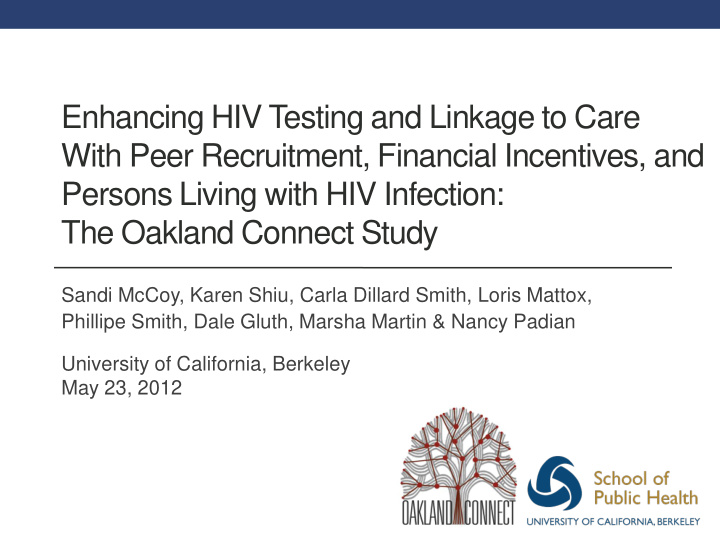



Enhancing HIV Testing and Linkage to Care With Peer Recruitment, Financial Incentives, and Persons Living with HIV Infection: The Oakland Connect Study Sandi McCoy, Karen Shiu, Carla Dillard Smith, Loris Mattox, Phillipe Smith, Dale Gluth, Marsha Martin & Nancy Padian University of California, Berkeley May 23, 2012
The Oakland Connect Team
Background • Timely detection of HIV infection and linkage to care and treatment are associated with increased survival and reduced onward transmission. • However, 1 in 5 people living with HIV/AIDS (PLHIV) in the U.S. do not know their serostatus. • New non-stigmatizing strategies to increase demand for HIV testing are needed, especially among African American adults who are disproportionately affected by HIV/AIDS. Source: CDC. Vital Signs: HIV Testing and Diagnosis Among Adults --- United States, 2001 — 2009. MMWR 2010;59(47):1550-1555
Alameda County AIDS Case Rates Whites 140 African Amer Asian/Pac Isl 120 Latinos Per 100,000 population 100 80 60 4x 40 20 0 Source: Bautista E & Marr A. HIV & AIDS Cases in Alameda County. Presentation to the CCPC, August 24, 2011.
Oakland Connect Objectives 1. Compare the effectiveness of respondent driven sampling (RDS) with two incentive structures for increasing demand for HIV testing among 30-60 year old African American adults residing in Oakland, California. 2. Determine if the HIV status of recruiters is associated with differences in the total number of recruits and the number of high-risk recruits.
Two Reward Schemes Networks Initiated by HIV- and HIV+ “seeds” for Recruiting Others PLHIV New HIV+ Flat Bonus Rewards Rewards 10 HIV+ seeds 30 high-risk HIV- seeds 243 recruits 8 low-risk HIV- seeds
Results • Incentives were critical for recruitment, but no difference in the number of total or high risk recruits between the two incentive schemes (p=0.53 and 0.40, respectively). • Networks initiated by PLHIV had more high-risk recruits than networks initiated by HIV- seeds (83% vs. 67%, p<0.05). • Nine (3.7%) recruits tested HIV positive; 7 (78%) were previously reported to the Alameda County Public Health Department (ACPHD) • Six had no evidence of care in the last 6 months • A unexpected finding: Is RDS a good mechanism to help re-connect PLHIV into care?
Acknowledgements UC Berkeley CAL-PEP Karen Shiu Jamila Shipp Carla Dillard Smith Tyler Martz Lisa Ryan Gloria Lockett Heena Shah Nancy Padian Volunteers of America Phillipe Smith Get Screened Oakland Maurice Tobin Marsha Martin Sharyn Grayson Adriann McCall Kerry Barlow HEPPAC Michael Snow Melissa Struzzo AHF/Out of the Closet Braunz Courtney Dale Gluth Loris Mattox Ses Soltani Amber Young Juba Johnson
Recommend
More recommend